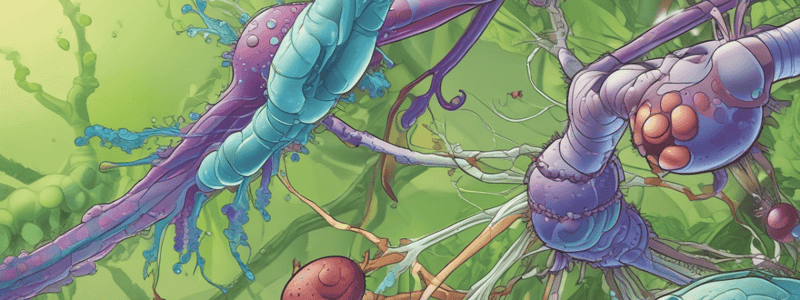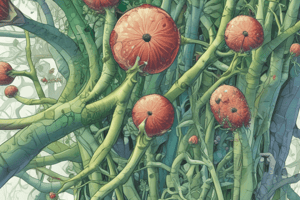Podcast
Questions and Answers
What is the name of the type of tropism where the growth response is towards water or moisture?
What is the name of the type of tropism where the growth response is towards water or moisture?
- Hydrotropism (correct)
- Phototropism
- Electrotropism
- Thermotropism
Which type of tropism is responsible for roots growing away from a rock when they come into contact with it?
Which type of tropism is responsible for roots growing away from a rock when they come into contact with it?
- Hydrotropism
- Thigmotropism (correct)
- Negative Tropism
- Gravitropism
What type of movement is observed in Mimosa pudica when its leaflets droop down when touched?
What type of movement is observed in Mimosa pudica when its leaflets droop down when touched?
- Nastic Movement (correct)
- Thigmotropism
- Gravitropism
- Phototropism
Which of the following is an example of positive thigmotropism?
Which of the following is an example of positive thigmotropism?
What is the name of the type of tropism where an organism shows movement response to temperature changes?
What is the name of the type of tropism where an organism shows movement response to temperature changes?
What type of tropism is responsible for plant roots growing downward towards gravity?
What type of tropism is responsible for plant roots growing downward towards gravity?
Which of the following is an example of negative tropism?
Which of the following is an example of negative tropism?
Which type of tropism is responsible for an organism's response to an electric field?
Which type of tropism is responsible for an organism's response to an electric field?
What is the name of the type of tropism where an organism shows a response to sunlight?
What is the name of the type of tropism where an organism shows a response to sunlight?
What is the term for the growth or movement of an organism in response to a touch stimulus?
What is the term for the growth or movement of an organism in response to a touch stimulus?
What is the role of statoliths in plant cells?
What is the role of statoliths in plant cells?
Which type of movement is characterized by growth or movement perpendicular to the direction of the stimulus?
Which type of movement is characterized by growth or movement perpendicular to the direction of the stimulus?
What is the term for the growth or movement of an organism in response to water or moisture?
What is the term for the growth or movement of an organism in response to water or moisture?
Which type of tropism is responsible for the growth of roots towards higher relative humidity levels?
Which type of tropism is responsible for the growth of roots towards higher relative humidity levels?
What is the direction of growth in negative thigmotropism?
What is the direction of growth in negative thigmotropism?
Which type of cell has been reported to show electrotropism?
Which type of cell has been reported to show electrotropism?
What is the term for the movement response of an organism to an electric field?
What is the term for the movement response of an organism to an electric field?
Which type of tropism is responsible for the growth of roots downward towards gravity?
Which type of tropism is responsible for the growth of roots downward towards gravity?
What is the term for the growth or movement of an organism in response to temperature changes?
What is the term for the growth or movement of an organism in response to temperature changes?
Which type of tropism is responsible for an organism's response to sunlight?
Which type of tropism is responsible for an organism's response to sunlight?
Flashcards are hidden until you start studying
Study Notes
The Meaning of Tropism
- Tropism is the ability of an organism to respond to a stimulus by turning from one direction to another.
- It is attained by active movement or through a change in the structure of the organism.
- Tropism refers to the growth response of an organism to a stimulus, rather than the movement of the organism.
- It can be positive (toward the stimulus) or negative (away from the stimulus).
Organ and Tissue Tropism
- Organ or tissue tropism shows the ability of a pathogen to invade a specific organ or a group of organs.
- Some pathogens are broadly tropic, infecting many organs, while others are restricted to a specific tissue.
- The capability of a pathogen to infect specific organs might differ over a disease course and could be active.
Pathogen-Mediated Infection
- The ability of a pathogen to infect also requires a previous skin break or a vector bite.
- Microorganisms may be pathogenic or non-pathogenic.
- The severity of the disease is influenced by factors associated with the pathogen and host.
Interactions with Organ and Tissue Niches
- It is important to study the interaction of the pathogen with organ and tissue niches.
- Variations in tropism can be seen in different pathogens, such as Staphylococcus aureus, Trypanosoma brucei, and influenza viruses.
Types of Tropism in Plants
- There are many forms of tropism in plants, including:
- Phototropism: growth or movement toward light
- Geotropism: growth or movement in response to gravity
- Chemotropism: growth or movement in response to chemicals
- Hydrotropism: growth or movement in response to water or moisture
- Thigmotropism: growth or movement in response to touch
- Heliotropism: growth or movement in response to sunlight
- Thermotropism: growth or movement in response to temperature changes
- Electrotropism: growth or movement in response to an electric field
Auxin and Directional Growth
- Auxin plays a major role in growth-mediated plant movements.
- Auxin can either promote or inhibit cell elongation.
- Auxin is produced at the apical region of the shoot and gets carried to other plant parts through auxin carrier proteins.
Plant Cell Growth and Turgor Pressure
- Plant cells exhibit slow, growth-mediated tropic movements.
- All movements of the plants are regulated by the interactions between intracellular turgor pressure and the plant cell wall.
- Fast movements in carnivorous plants are driven by quick changes in water transport supported by mechanical instabilities in the structure of the plants.
The Meaning of Tropism
- Tropism is the ability of an organism to respond to a stimulus by turning from one direction to another.
- It is attained by active movement or through a change in the structure of the organism.
- Tropism refers to the growth response of an organism to a stimulus, rather than the movement of the organism.
- It can be positive (toward the stimulus) or negative (away from the stimulus).
Organ and Tissue Tropism
- Organ or tissue tropism shows the ability of a pathogen to invade a specific organ or a group of organs.
- Some pathogens are broadly tropic, infecting many organs, while others are restricted to a specific tissue.
- The capability of a pathogen to infect specific organs might differ over a disease course and could be active.
Pathogen-Mediated Infection
- The ability of a pathogen to infect also requires a previous skin break or a vector bite.
- Microorganisms may be pathogenic or non-pathogenic.
- The severity of the disease is influenced by factors associated with the pathogen and host.
Interactions with Organ and Tissue Niches
- It is important to study the interaction of the pathogen with organ and tissue niches.
- Variations in tropism can be seen in different pathogens, such as Staphylococcus aureus, Trypanosoma brucei, and influenza viruses.
Types of Tropism in Plants
- There are many forms of tropism in plants, including:
- Phototropism: growth or movement toward light
- Geotropism: growth or movement in response to gravity
- Chemotropism: growth or movement in response to chemicals
- Hydrotropism: growth or movement in response to water or moisture
- Thigmotropism: growth or movement in response to touch
- Heliotropism: growth or movement in response to sunlight
- Thermotropism: growth or movement in response to temperature changes
- Electrotropism: growth or movement in response to an electric field
Auxin and Directional Growth
- Auxin plays a major role in growth-mediated plant movements.
- Auxin can either promote or inhibit cell elongation.
- Auxin is produced at the apical region of the shoot and gets carried to other plant parts through auxin carrier proteins.
Plant Cell Growth and Turgor Pressure
- Plant cells exhibit slow, growth-mediated tropic movements.
- All movements of the plants are regulated by the interactions between intracellular turgor pressure and the plant cell wall.
- Fast movements in carnivorous plants are driven by quick changes in water transport supported by mechanical instabilities in the structure of the plants.
Studying That Suits You
Use AI to generate personalized quizzes and flashcards to suit your learning preferences.




